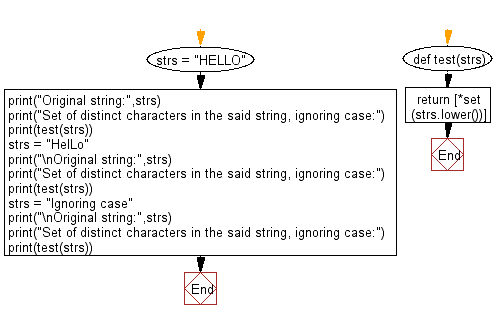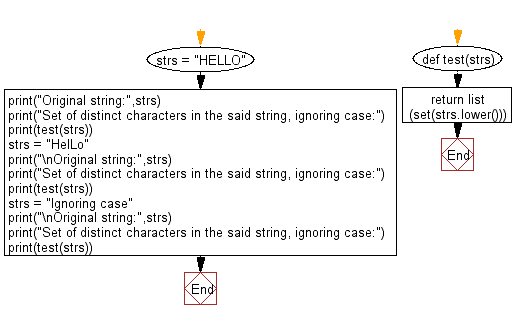Python: Find the set of distinct characters in a string, ignoring case
Python Programming Puzzles: Exercise-42 with Solution
Write a Python program to find the set of distinct characters in a given string, ignoring case.
Input: HELLO Output: ['h', 'o', 'l', 'e'] Input: HelLo Output: ['h', 'o', 'l', 'e'] Input: Ignoring case Output: ['s', 'n', 'c', 'o', 'e', 'i', 'r', 'g', 'a', ' ']
Pictorial Presentation:

Sample Solution-1:
Python Code:
#License: https://bit.ly/3oLErEI
def test(strs):
return [*set(strs.lower())]
strs = "HELLO"
print("Original string:",strs)
print("Set of distinct characters in the said string, ignoring case:")
print(test(strs))
strs = "HelLo"
print("\nOriginal string:",strs)
print("Set of distinct characters in the said string, ignoring case:")
print(test(strs))
strs = "Ignoring case"
print("\nOriginal string:",strs)
print("Set of distinct characters in the said string, ignoring case:")
print(test(strs))
Sample Output:
Original string: HELLO Set of distinct characters in the said string, ignoring case: ['o', 'e', 'l', 'h'] Original string: HelLo Set of distinct characters in the said string, ignoring case: ['o', 'e', 'l', 'h'] Original string: Ignoring case Set of distinct characters in the said string, ignoring case: ['o', ' ', 'i', 'r', 'e', 'g', 'a', 'n', 'c', 's']
Flowchart:

Visualize Python code execution:
The following tool visualize what the computer is doing step-by-step as it executes the said program:
Sample Solution-2:
Python Code:
#License: https://bit.ly/3oLErEI
def test(strs):
return list(set(strs.lower()))
strs = "HELLO"
print("Original string:",strs)
print("Set of distinct characters in the said string, ignoring case:")
print(test(strs))
strs = "HelLo"
print("\nOriginal string:",strs)
print("Set of distinct characters in the said string, ignoring case:")
print(test(strs))
strs = "Ignoring case"
print("\nOriginal string:",strs)
print("Set of distinct characters in the said string, ignoring case:")
print(test(strs))
Sample Output:
Original string: HELLO Set of distinct characters in the said string, ignoring case: ['h', 'o', 'l', 'e'] Original string: HelLo Set of distinct characters in the said string, ignoring case: ['h', 'o', 'l', 'e'] Original string: Ignoring case Set of distinct characters in the said string, ignoring case: ['s', 'n', 'c', 'o', 'e', 'i', 'r', 'g', 'a', ' ']
Flowchart:

Visualize Python code execution:
The following tool visualize what the computer is doing step-by-step as it executes the said program:
Python Code Editor :
Have another way to solve this solution? Contribute your code (and comments) through Disqus.
Previous: Sort numbers based on strings.
Next: Find all words in a given string with n consonants.
What is the difficulty level of this exercise?
Test your Programming skills with w3resource's quiz.
Python: Tips of the Day
Find current directory and file's directory:
To get the full path to the directory a Python file is contained in, write this in that file:
import os dir_path = os.path.dirname(os.path.realpath(__file__))
(Note that the incantation above won't work if you've already used os.chdir() to change your current working directory, since the value of the __file__ constant is relative to the current working directory and is not changed by an os.chdir() call.)
To get the current working directory use
import os cwd = os.getcwd()
Documentation references for the modules, constants and functions used above:
- The os and os.path modules.
- The __file__ constant
- os.path.realpath(path) (returns "the canonical path of the specified filename, eliminating any symbolic links encountered in the path")
- os.path.dirname(path) (returns "the directory name of pathname path")
- os.getcwd() (returns "a string representing the current working directory")
- os.chdir(path) ("change the current working directory to path")
Ref: https://bit.ly/3fy0R6m
- New Content published on w3resource:
- HTML-CSS Practical: Exercises, Practice, Solution
- Java Regular Expression: Exercises, Practice, Solution
- Scala Programming Exercises, Practice, Solution
- Python Itertools exercises
- Python Numpy exercises
- Python GeoPy Package exercises
- Python Pandas exercises
- Python nltk exercises
- Python BeautifulSoup exercises
- Form Template
- Composer - PHP Package Manager
- PHPUnit - PHP Testing
- Laravel - PHP Framework
- Angular - JavaScript Framework
- Vue - JavaScript Framework
- Jest - JavaScript Testing Framework
